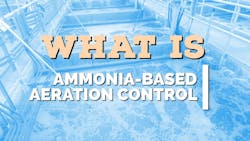What is ammonia-based aeration control (ABAC)?
What you will learn
- What ammonia-based aeration control (ABAC) is.
- How ABAC works and the technologies necessary to achieve it.
- The difference between feed-forward and feed-back systems.
- Why ABAC is useful for wastewater treatment plants.
In a wastewater treatment plant, the incoming influent generally includes nitrogen in the form of ammonia which is usually present in the water as ammonium ions. The ammonia/ammonium is converted into nitrite via the actions of ammonia-oxidizing bacteria and the nitrite is converted into nitrate via the actions of nitrite-oxidizing bacteria. This process, namely the conversion of ammonia to nitrite and nitrite to nitrate is called nitrification and requires oxygen. Nitrate can be converted into nitrogen gas in a process called denitrification for which no oxygen is required.
The oxygen in the aeration tank in the wastewater treatment plant is in the form of dissolved oxygen (DO). Because the concentration of DO can affect the rate of nitrification, there is a need to control the DO concentration and to monitor the ammonia/ammonium concentration. Ammonia-based aeration control (ABAC) does this controlling and monitoring.
What is ammonia-based aeration control (ABAC)?
Ammonia-based aeration control (ABAC) is a process in wastewater operations that controls the flow of air delivered in aeration tanks and thus the DO concentration by monitoring the ammonia concentration data in real-time. Although there are several ABAC strategies that will be discussed in this article, the benefits of the ABAC process stands out: it is an energy-efficient and a reliable process for monitoring the ammonia concentration and for controlling the air flow delivered to the aeration tanks in the wastewater treatment plants.
How does ABAC work?
Because ABAC controls the flow of air to aeration tanks by monitoring the ammonia concentration data in real-time, the ABAC process requires analyzers and probes, both of which use electrodes to measure the ammonia concentration. While analyzers involve pumping out a sample of the mixed liquor and filtering it prior to analyzing it using a gas sensitive electrode, probes use ion selective electrodes.
What is needed for ABAC to work?
For ABAC to work, it is important to control the aeration based on the ammonia/ammonium measurement. This requires applicable control strategies, some of which are:
- Direct control using ammonium measurement: In this strategy, the aeration rate is controlled directly based on the ammonium measurement. Using ion selective electrodes, the concentration of ammonium is measured to ensure that nitrification is complete. The advantage of this strategy is that blowers can be used to maintain the ammonium concentration between set points.
- Cascade control arrangement for optimizing nitrification and DO concentrations: In the cascade control arrangement, both nitrification and DO concentrations are optimized. Ammonium and DO sensors are used in this set-up to measure the concentrations of ammonium and DO respectively along with comparing the measurements with the setpoint values. This arrangement also includes an airflow sensor and depending on the technology, the controllers can work in coordination.
A potential drawback of the cascade control arrangement is that it requires determining where to locate the sensors, including the DO sensor particularly for plug flow reactors. Compared to a completely mixed configuration where the sensor location is irrelevant because the concentration of DO is the same throughout the reactor, in a plug flow configuration the concentration of DO varies in the reactor, with higher concentration upstream and lower concentration downstream.
- Feed forward control: In the feed forward control strategy, the ammonium concentration upstream is measured to control the downstream aeration rate. While this could be done via mathematical models, a practical tested approach is the use of a blower. The blower maintains a minimum airflow to maintain the mixing while also monitoring the upstream ammonium concentration.
What is the difference between feed-forward and feed-back ammonia-based aeration control?
Feed forward aeration control is based on measuring the upstream ammonium concentration to control the DO concentration downstream while in feed-back ammonia-based aeration, the aeration is controlled based on the ammonium measurement in the feedback. Feed-back ammonia-based aeration control can be in a cascade set-up with the location of the sensors depending on whether the bioreactor is in a continuous mixed configuration or in a plug-flow configuration.
Why is ABAC used in wastewater treatment plants?
Monitoring the ammonium concentration in wastewater treatment plants and adjusting the DO concentration via aeration is useful for healthy chemical dynamics in wastewater treatment. This monitoring and adjustment is achieved by using ABAC.
The use of ABAC is advantageous over DO control processes, and two reasons are commonly referenced.
- The ABAC process allows for more efficient aeration and thus saves more energy compared to the use of traditional DO control processes. Specifically between 10 to 20% more energy could be saved using ABAC processes compared to the use of DO control processes.
- Compared to conventional DO control, the ABAC process promotes nitrification resulting in lower concentration of total nitrogen in the effluent.
ABAC is a strategy-flexible and energy-saving approach for maintaining the nitrification process by monitoring the ammonia concentration and thus relying on it for determining the quantity of aeration to add in the aeration tank of a wastewater treatment plant.
The selection of a strategy, namely direct control, cascade control, feed forward control, or feedback control, depends on the chemical and physical characteristics of the wastewater influent and on the construction and operation of the wastewater treatment plant.
Therefore a selected ABAC strategy might have unique features. However, because ABAC involves the use of electrodes to measure the ammonia concentration, proper training in using these electrodes is required along with staying informed on the ever-changing electrode technologies in these applications.
Take a quiz about ammonia-based aeration control
About the Author
Saleha Kuzniewski
Saleha Kuzniewski, Ph.D. has authored several publications in the fields of scientific research, biotechnology, and environmental regulations. She is the winner of the 2023 Apex award for publication excellence. She is also the founder of Environmental Remediation & Innovations, LLC. Kuzniewski can be reached at [email protected].

